For a long time, Google Ads has been a behemothSomething that is enormous or very powerful. when it comes to digital advertising.
However, if its latest addition to this giant is any indication, it just went to the next level: Performance Max campaigns.
If you want an ad to get maximum exposure across all of Google’s platforms like Search, Display, YouTube, DiscoverGoogle's feed that shows content to users based on their interests and activities., GmailGoogle's free email service that integrates with other Google services., among others, then Performance Max campaigns may be your ticket.
The ensuing tutorial will explain in detail what you need to know to make the most of this feature.
Whether you are an experienced marketer or a beginner who has just started your journey with Google Ads, Performance Max campaigns can give you the significant edge you might always be striving for.
Ready to unlock its full potential?
Let’s dive in!
- Performance Max Campaigns: Introduction
- Setting Up Your First Performance Max Campaign
- Optimizing Performance Max Campaigns for Better Results
- Performance Max Campaign: Monitoring and Analysis
- Advanced Tips and Strategies for Performance Max Campaigns
- Maximizing Performance Max Campaigns: Final Overview
- Performance Max Campaigns: Frequently Asked Questions
Performance Max Campaigns: Introduction
So, what exactly is a Performance Max campaign?
At their core, they’re goal-based ad formats designed to drive optimal performance across Google networks with a single campaign.
They’re driven by Google’s machine learning algorithms that help you drive more conversions by showing your ads to the right people at the right time.
The beauty of Performance Max lies in consolidating ad efforts into one streamlined campaign and not having to manage several campaigns targeting different parts of Google’s ecosystem.
But that’s not all: Google continuously optimizes your ads with its AI in real time, and your campaign gets better and better with more data ingested.

A visual representation of unified Performance Max campaigns, highlighting cross-platform advertising and real-time AI optimization.
What Are Performance Max Campaigns?
Performance Max campaigns are a new multi-channel campaign type that includes all of Google’s ad inventory in one single campaign, including Search, Display, YouTube, and Discovery ads.
You get to spread your budget and effort across all available channels instead of focusing on just one type of ad.
Google’s machine learning system figures out the right mix of ads to serve and where they should appear to ensure you’re getting the best possible outcome.
This type of campaign is perfect for advertisers interested in scaling their advertising on Google properties without micromanaging every single campaign.
Google optimizes the ads for your objectives, whether that’s driving traffic, generating leads, or boosting sales.
You set the objectives, and Performance Max takes care of the rest.

Visual representation of the advantages of using Performance Max in Google Ads, emphasizing AI optimization across multiple digital platforms.
Why Use Performance Max in Google Ads?
The main reason to use Performance Max campaigns is simple: it makes your results better while requiring less effort.
With machine learning, Google will automatically show your ads to the most relevant users at the best moments of their journey, increasing your chances for conversions.
Performance Max enables advertisers to run ads on many platforms easily without needing to waste much time and resources managing separate campaigns.
Another reason to use Performance Max is the comprehensive reporting that it provides.
You’ll get insights not only into how your ads are performing but also into which platforms and audience segments are yielding the best ROI.
This will help you make data-driven decisions to further optimize your campaigns.
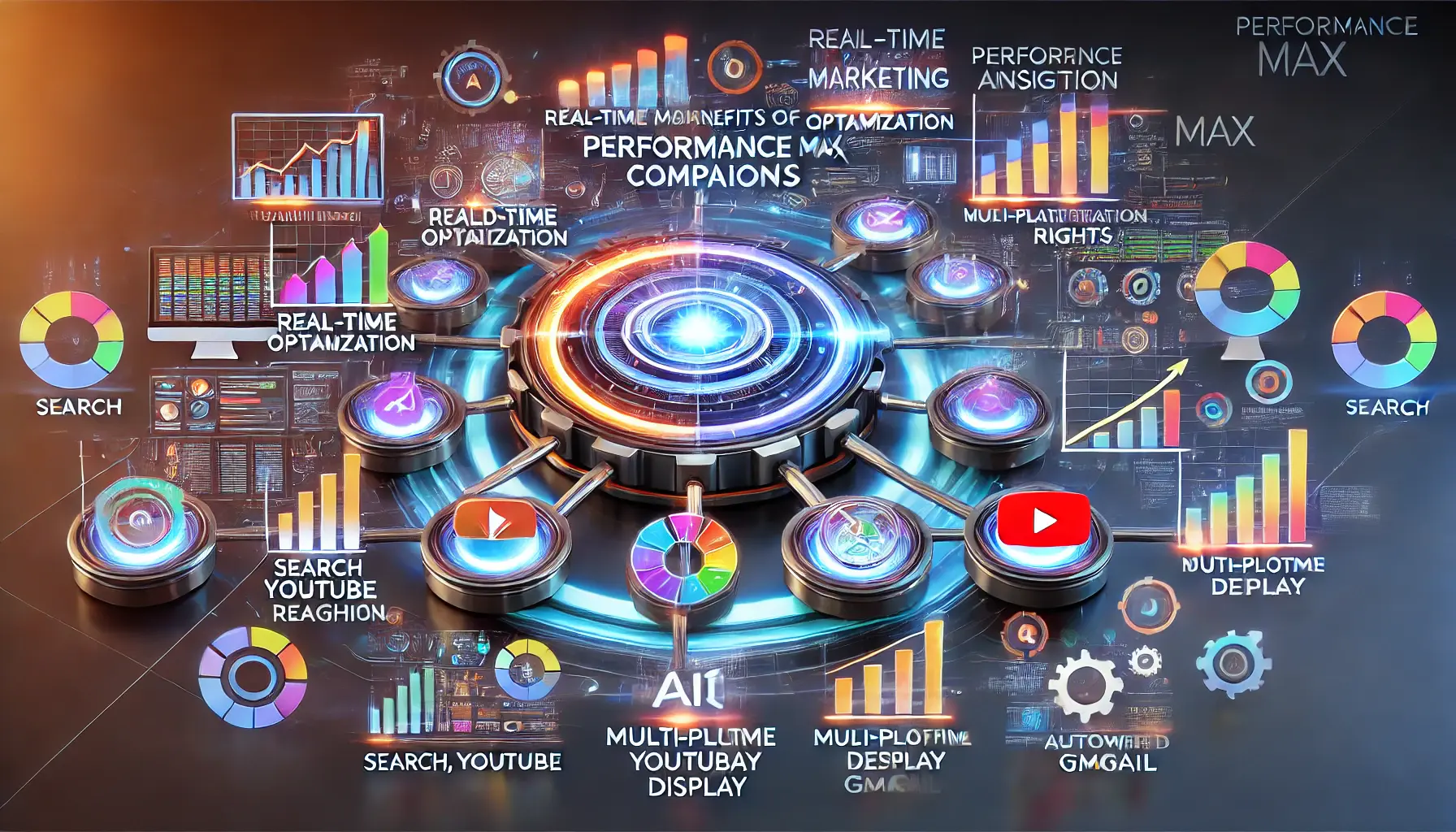
Visual representation of the key benefits of Performance Max campaigns for advertisers, highlighting real-time optimization, multi-platform reach, and AI-powered automation.
Key Benefits of Performance Max for Advertisers
The following are the key benefits that Performance Max campaigns offer to advertisers:
- Unified Campaigns: Drive ads on every type of Google property in one campaign, saving time and effort.
- Real-time Optimization: Google’s machine learning continuously enhances your ads as more data is gathered, improving results over time.
- Cross-Channel Reach: Reach your target customers on Search, YouTube, Display, Gmail, and Discovery—all from one single campaign.
- Goal-Oriented: Set goals, whether it’s sales, leads, or website traffic, and Google will automatically optimize for those goals.
- Data Insights: Receive comprehensive data insights on which channels and audiences perform the best.
Performance Max campaigns unify all Google ad channels in one streamlined campaign, allowing you to maximize conversions with less management effort.
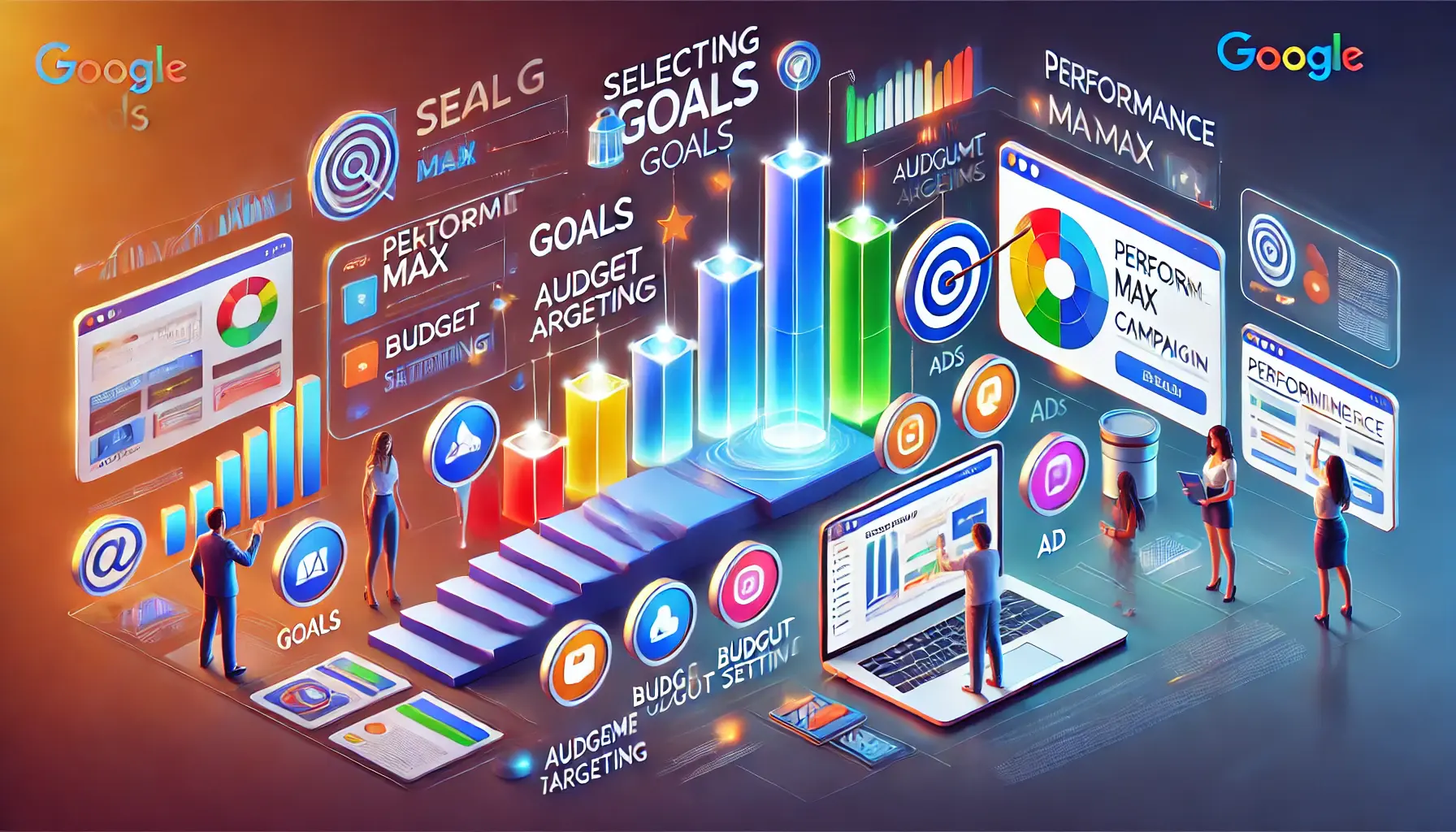
An illustration showing the process of setting up a Performance Max campaign, symbolizing goal selection, audience targeting, and budget management.
Setting Up Your First Performance Max Campaign
Setting up a Performance Max campaign might sound daunting, but Google has made the process as smooth as possible.
Whether you are an old veteran of Google Ads or just starting out, there is no substitute for a clear, step-by-step process to ensure that your campaign launches smoothly.
The key really lies in defining your goals early and making sure your campaign setup aligns with these goals.
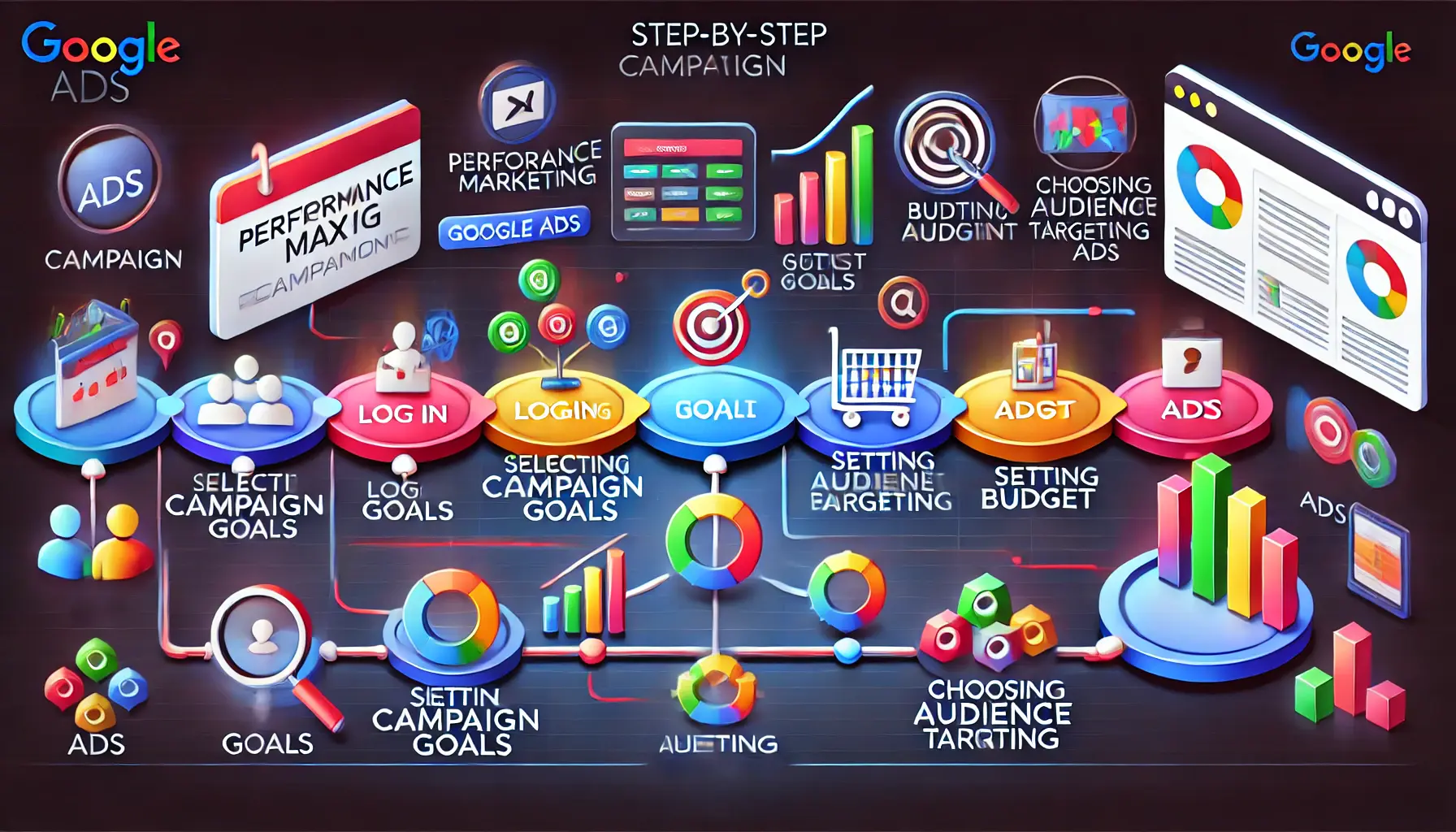
A visual representation of the step-by-step setup process for a Performance Max campaign, depicting key stages like goal selection, budget setting, and audience targeting.
Step-by-Step Setup Process
Here’s how you can set up your first Performance Max campaign, step by step:
- Step 1: Log into Google Ads to begin the process. First things first, log in to your account. On the dashboard, click ‘New Campaign’ and select Performance Max from the options.
- Step 2: Define Your Campaign Goals. Choose what you want to achieve from this campaign. It may be anything from website traffic to lead generation or sales. Ensure that your goal is specific and relevant to your business objectives.
- Step 3: Budget and Bidding Strategy. Set your daily or monthly budget for the campaign and choose the appropriate bidding strategy. Google’s AI will work within this budget to maximize conversions, so make sure it reflects the capacity of your business.
- Step 4: Audience Targeting and Signals. Much of the heavy lifting will be done by Google’s machine learning; however, you can always guide it by feeding in audience signals. Utilize your customer data or select one of many pre-defined audience segments to help Google find the right users.
- Step 5: Creating Ad Assets. Create great ad assets such as images, videos, and headlines. Performance Max works best when you provide high-quality creative content. Google will automatically combine and test different combinations to serve the most effective ads.
- Step 6: Conversion Tracking. If you haven’t set up conversion tracking, do so. It’s the most important element for knowing if your campaign was successful or not, as it allows you to track how many users completed the intended actions, whether that’s purchasing products or signing up for your newsletter.
- Step 7: Review and Launch. Once everything is in place, review your campaign settings and launch. Google will begin optimizing your ads immediately, but remember to keep an eye on the performance metrics to make adjustments as needed.

A visual representation of choosing the right objectives for a Performance Max campaign, depicting goals such as sales, leads, traffic, and brand awareness.
Choosing the Right Campaign Objectives
It is very important to choose the right objectives in Performance Max campaigns.
The goals you set will inform Google’s algorithmA set of rules or calculations followed by a computer to solve problems or perform tasks. on how to optimize your ads.
For example, if you are focused on sales, then Google will prioritize conversions over impressions.
The following are some of the most common objectives:
- Sales: Focuses on driving purchases and transactions.
- Leads: Targets users who are likely to submit contact information, sign up for newsletters, or request more information.
- Website Traffic: Directs users to specific pages on your website, ideal for content-heavy businesses.
- Brand Awareness: Maximizes your reach, helping more people recognize your brand across different platforms.
Be sure to select an objective that aligns with your business goals to maximize the effectiveness of your Performance Max campaign.

A visual representation of audience targeting and selection in Performance Max campaigns, highlighting precision targeting through audience segments and data-driven insights.
Targeting and Audience Selection in Performance Max
While Google’s algorithms are incredibly powerful, providing the correct audience signals will make the biggest difference in the success of your Performance Max campaigns.
Here’s how to improve audience targeting:
- First-Party Data: Leverage your own customer data, such as email lists or prior purchase information, as an effective way to target users who are highly likely to engage with your brand.
- Custom Audiences: Create custom audience segments based on demographics, interests, or browsing behaviors. This helps Google find users who are more likely to convert.
- Affinity Audiences: Locate users who have consistently shown interest in topics related to your product or service. This automatically raises the relevance of your ads.
- In-Market Audiences: Reach users who are actively looking for products or services similar to yours. This works exceptionally well for lead generation and e-commerce businesses.
With proper audience signals, Google can refine your campaign and provide a better opportunity for your ads to reach the most relevant users.
Defining your campaign goals early is crucial for aligning with Google’s optimization algorithms, ensuring a successful launch of your Performance Max campaign.
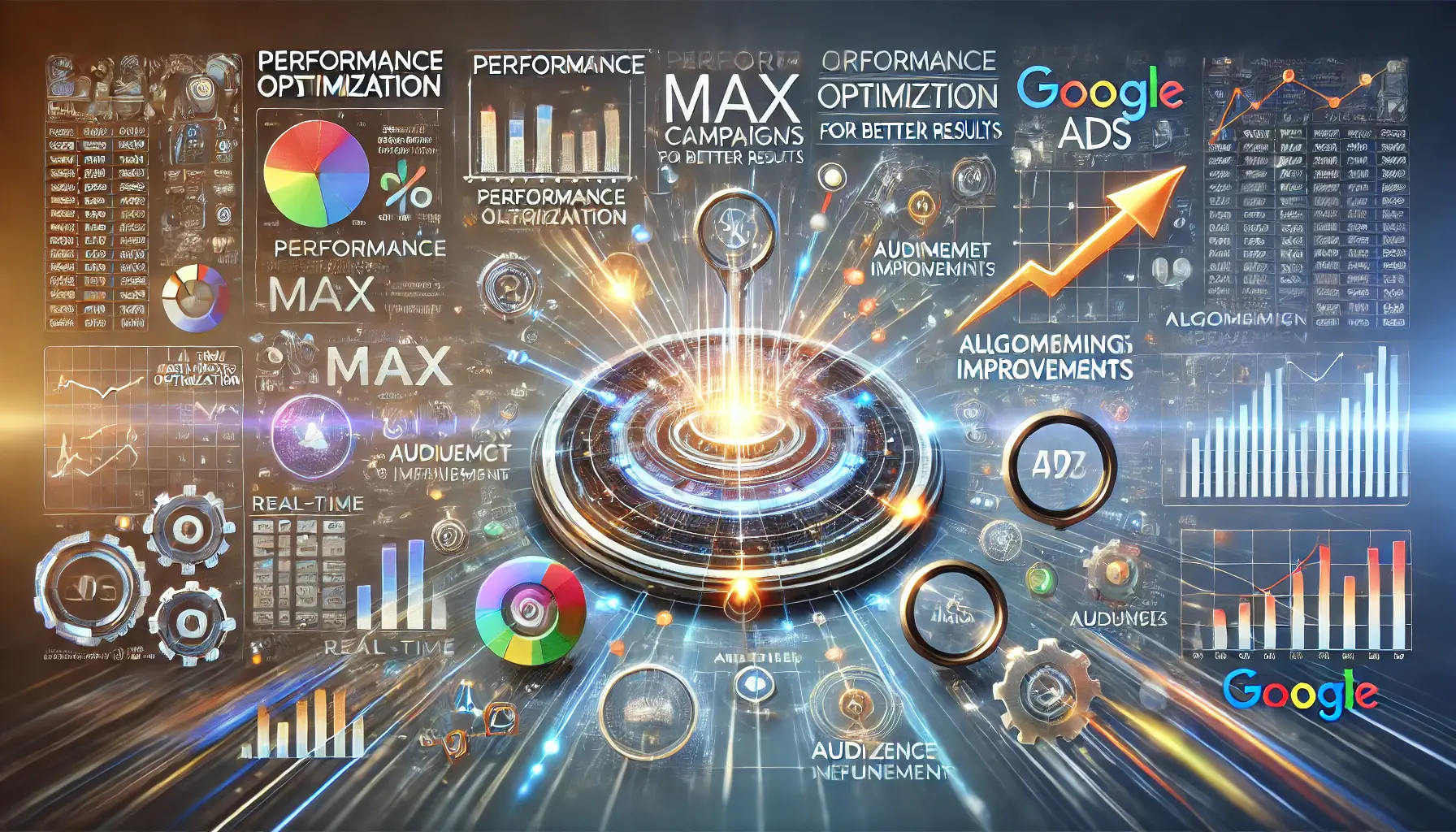
A visual representation of optimizing Performance Max campaigns, highlighting the role of data analysis, machine learning, and performance metrics for better results.
Optimizing Performance Max Campaigns for Better Results
Once your Performance Max campaign is up and running, optimization will play a major role in yielding the best results.
Though Google’s machine learning algorithms are quite powerful, there are several actions you can take to ensure your campaign performs even better.
Optimization is continuous, and even slight modifications can significantly impact your ROI.
In this section, we look at how to optimize Performance Max campaigns to achieve your business goals.

A visual representation of best practices for creative content in Performance Max campaigns, highlighting the optimization of images and videos for multi-platform display.
Best Practices for Creative in Performance Max
One of the most important steps to optimize your Performance Max campaign is providing high-quality, engaging creative assets.
These include the images, videos, and headlines your audience will see across Google platforms.
Follow these best practices for creative optimization:
- High-Resolution Visuals: Use high-quality images and videos that look crisp on all screen sizes and devices. Poor visuals reduce engagement and lower your brand’s credibility.
- Test Multiple Versions: Provide Google with a variety of images, videos, and headlines so the algorithm can test different combinations and find the ones that resonate best with your audience.
- Focus on Clear Messaging: Ensure your headlines and descriptions are short, clear, and directly communicate the value proposition of your product. Avoid using jargon or overly complex language.
- Include Strong Calls to Action (CTAs): Your creatives should always include strong CTAs, such as “Buy Now,” “Learn More,” or “Sign Up,” to drive users to take the desired action.
- Refresh Creatives Periodically: It is important to ensure that creatives remain fresh for continued user engagement. Rotate new images, videos, and headlines to avoid ad fatigue.

A visual representation of budgeting and bid strategies in Performance Max campaigns, highlighting budget allocation, bid management, and cost-per-click optimization.
Budgeting and Bid Strategies
Optimize your budget and bid strategy to ensure that your Performance Max campaign yields a high return on investment.
Here are some important tips for managing your budget and bids effectively:
- Set a Realistic Budget: Make sure your budget aligns with your campaign goals. For instance, if your goal is conversions, your budget should be sufficient to gather enough data for Google’s algorithm to optimize effectively.
- Leverage Automated Bidding Strategies: Google provides automated bidding strategies, including Maximize Conversions or Target CPA (Cost per Acquisition). These use machine learning to automatically adjust your bids for maximum performance, which works particularly well in Performance Max campaigns.
- Monitor Budget Utilization: Keep an eye on how your budget is being spent across different channels. You may find that certain platforms, like YouTube or Gmail, perform better than others, and you can adjust your budget accordingly.
- Adjust Bids for High-Performing Segments: Once you gather enough data, adjust your bids to focus more on high-performing audience segments or platforms, ensuring your budget is allocated most effectively.
- Test Bid Strategies: Feel free to test different bid strategies to understand which works best for your objectives. While Google’s machine learning optimizes your bids, testing is vital for fine-tuning.
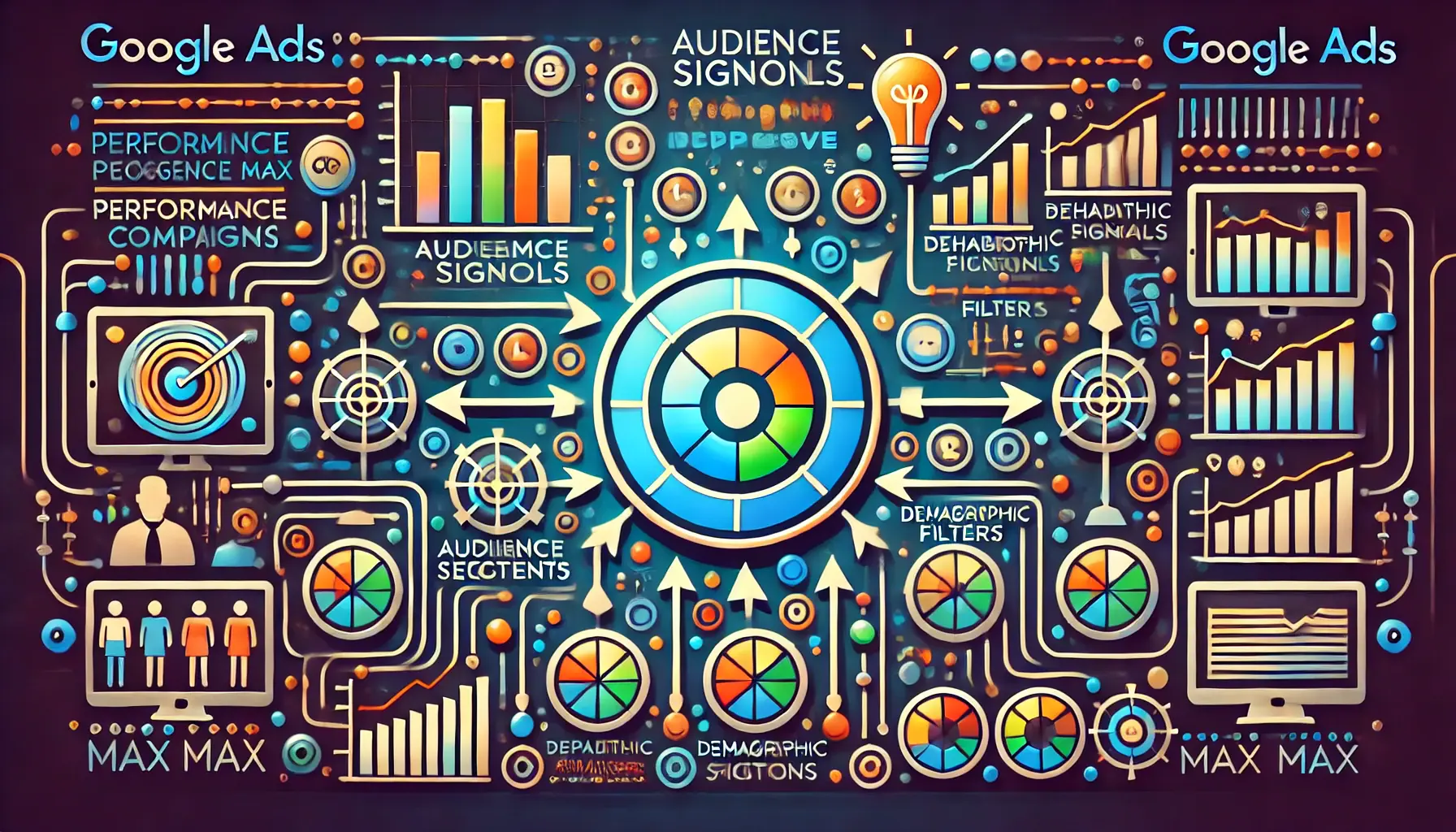
A visual representation of how audience signals refine targeting in Performance Max campaigns, symbolizing the use of data-driven optimization.
Improving Performance Using Audience Signals
Audience signals are one of the most impactful levers in driving Performance Max campaign performance.
While Google’s AI does much of the targeting work for you, giving it audience signals helps its algorithm reach users that are far more relevant.
Here’s how to optimize audience targeting:
- Upload First-Party Data: Utilize your pre-existing customer lists by uploading first-party data, such as email addresses or phone numbers. This helps Google target users who are already familiar with your brand.
- Target High-Intent Audiences: Leverage Google’s in-market audiences to target users actively searching for products or services similar to yours. This increases the chances of conversions.
- Re-target Custom Audiences: Target users based on their behaviors, interests, and demographics. Refine these segments as you gather more data on which audiences drive better results.
- Target Similar Audiences: Google’s machine learning can identify users whose behaviors are similar to your existing customer base. Targeting similar audiences helps scale reach without sacrificing relevance.
- Exclude Underperforming Audiences: Exclude audience segments that are not converting to ensure your budget is spent on users who are more likely to engage.
High-quality creative assets, combined with data insights, play a critical role in optimizing Performance Max campaigns for long-term success.
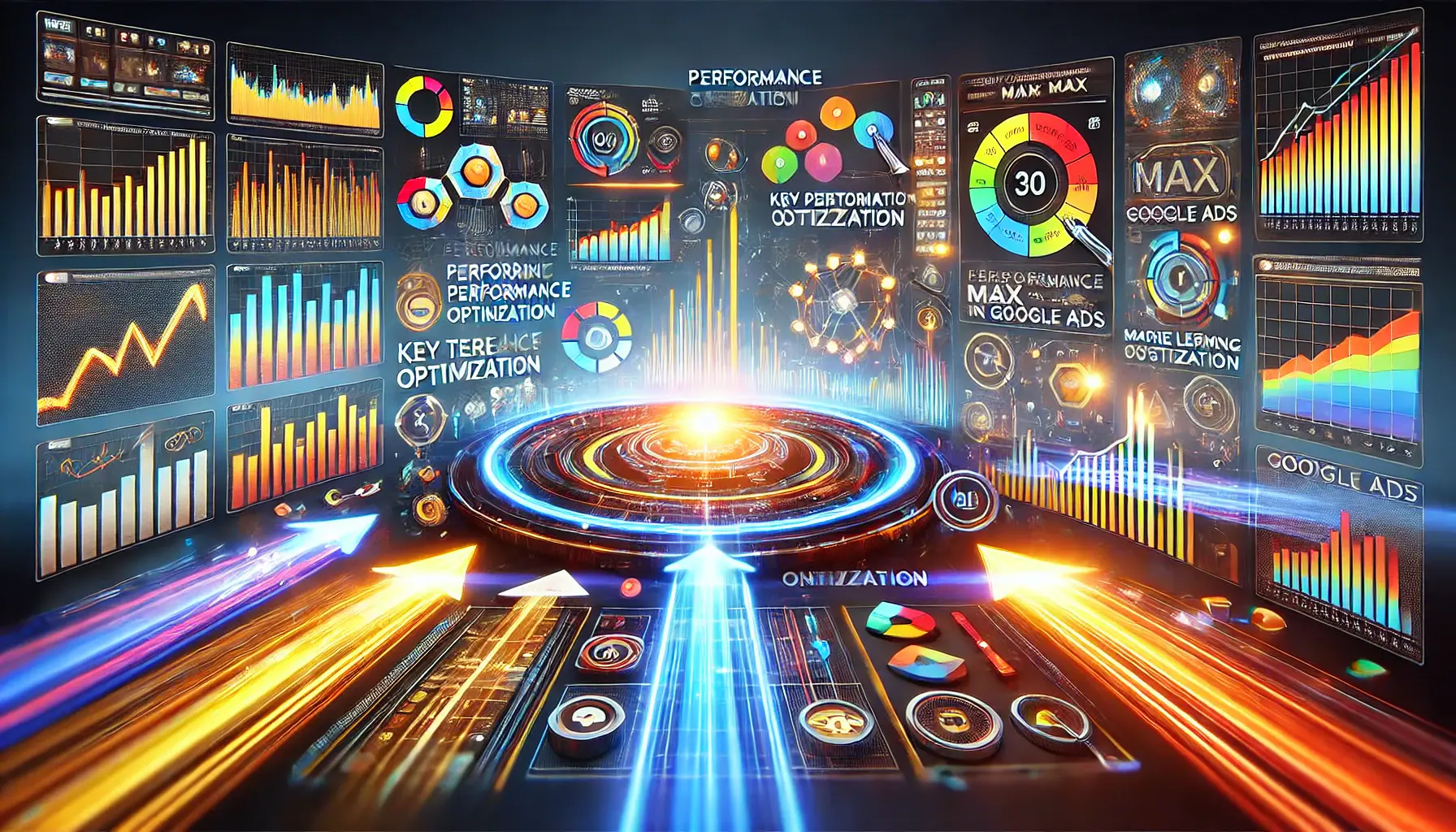
A visual representation of the monitoring and analysis process in Performance Max campaigns, highlighting real-time optimization and data-driven decision-making.
Performance Max Campaign: Monitoring and Analysis
Once your Performance Max campaign is up and running, tracking and analyzing its performance becomes instrumental in ensuring that it works effectively to achieve your goals.
Google Ads offers a wide array of reporting tools that provide insights into the performance of your ads across all channels.
Knowing how to interpret these reports and adjust your strategy based on the data helps you to continuously optimize your campaign.
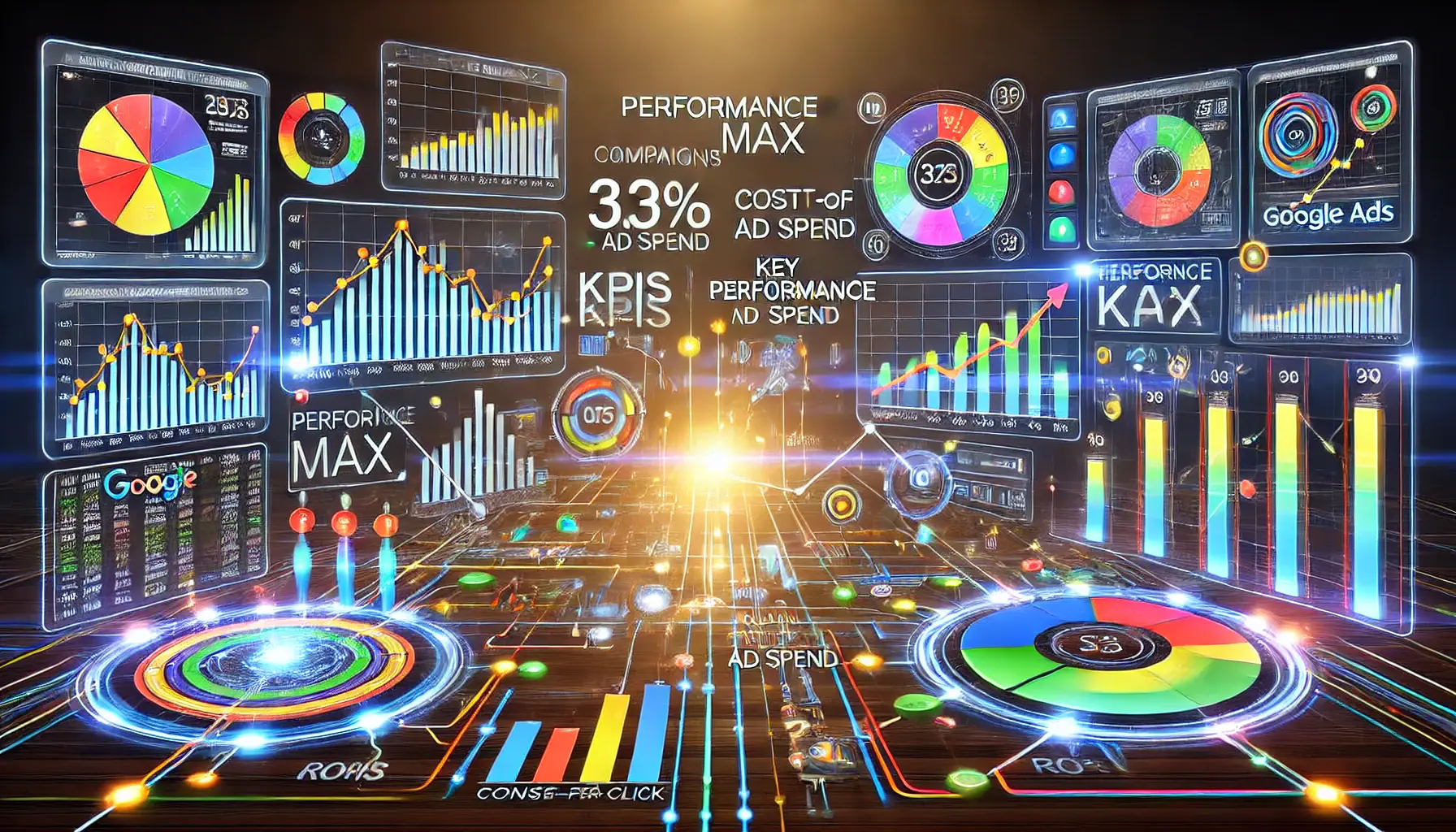
A visual representation of the key metrics to track in Performance Max campaigns, including performance indicators like conversions, cost-per-click, and ROAS.
Key Metrics to Track in Performance Max Campaigns
There are several key metrics that you can track to measure the effectiveness of your Performance Max campaign.
These metrics will help you understand ad performance, budget allocation, and the rate at which ads complete their desired conversions:
- Conversions: This is one of the most important metrics, as it tracks the number of desired actions (such as purchases, sign-ups, or downloads) that are completed as a result of your campaign.
- Cost per Conversion (CPA): CPA tells you how much you’re paying for each conversion. If your CPA is too high, it might be time to optimize your bids or reallocate budget toward better-performing segments.
- Click-Through Rate (CTR): CTR refers to the percentage of users who view your ad and then click on it. A low CTR could indicate that your ads do not appeal to your audience or that your creatives need to be reworked.
- Impressions: This metric measures the total number of times your ads are shown. While impressions do not guarantee conversions, they help gauge the visibility of your ads across platforms.
- Conversion Rate: This indicates the percentage of users who completed the desired action after viewing your ad. A higher conversion rate means your ads are effectively driving the desired actions.
- Return on Ad Spend (ROAS): ROAS is a critical metric that measures the financial return on your advertising efforts. It shows how much revenue is generated for every dollar spent on ads.
By regularly reviewing these metrics, you’ll gain a clearer view of how your Performance Max campaign is performing and be able to optimize your results accordingly.
A visual representation of using conversion tracking effectively in Performance Max campaigns, showing user actions, conversion funnels, and real-time tracking.
Using Conversion Tracking Effectively
Conversion tracking is essential for understanding the true performance of your Performance Max campaign.
Without it, you’re left speculating whether your ads are driving valuable actions.
Here’s how to use conversion tracking effectively:
- Set Up Conversion Tracking: If you haven’t already, set up conversion tracking in your Google Ads account. You can track various actions, such as purchases, form submissions, and calls from ads.
- Track Micro and Macro Conversions: Track both smaller micro-conversions (like clicks or video views) and larger goal-oriented conversions (like sales or sign-ups). This gives you a comprehensive view of user behavior.
- Check Conversion Windows: Understand your conversion window settings, which is the time frame in which a conversion is tracked after a user interacts with your ad. Adjust this window based on the typical buyer’s journey for your business.
- Monitor Attribution Models: Google provides several attribution models that assign credit for conversions across touchpoints. Choose the right model to ensure you’re accurately tracking the impact of each interaction on driving conversions.
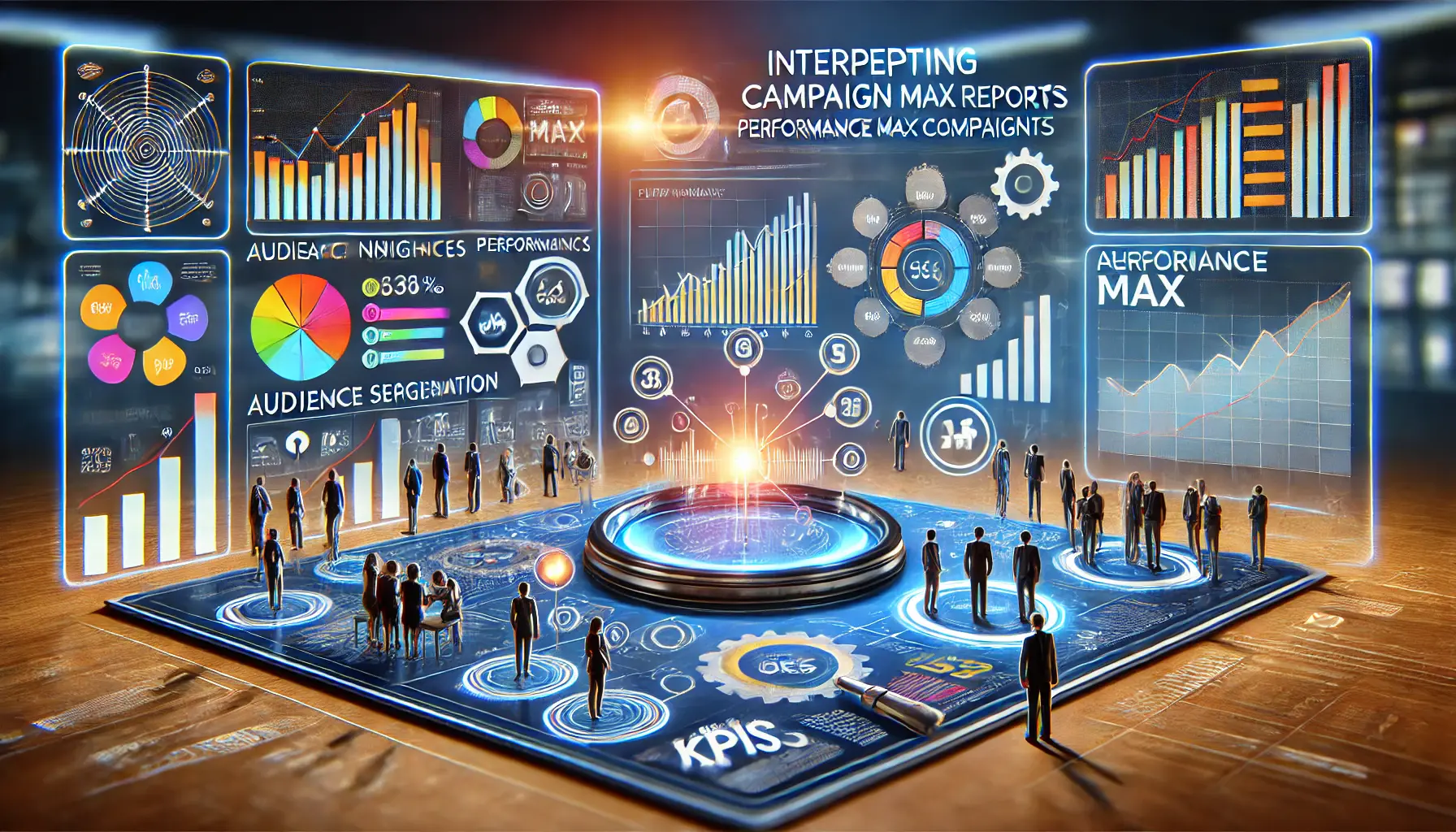
A visual representation of interpreting campaign insights and reports in Performance Max campaigns, featuring data analysis and real-time performance tracking.
Interpreting Campaign Insights and Reports
Understanding and interpreting reports from Google Ads regarding your Performance Max campaign is key to ongoing optimization.
These tools help you dive deeper into the data and extract actionable insights:
- Asset Insights: Google provides insights into which ad assets (images, videos, and headlines) are performing best. Review these insights regularly to understand what resonates with your audience and adjust your creatives accordingly.
- Audience Insights: Performance Max campaigns provide data on which audience segments are driving the most conversions. Use this data to refine your audience signals and focus on the highest-converting segments.
- Cross-Channel Performance: One of the strengths of Performance Max is its ability to run ads across multiple platforms. Google Ads reports will show you how each channel (Search, Display, YouTube, etc.) is contributing to your overall campaign performance.
- Data-Driven Attribution: This feature in Google Ads automatically assigns credit to the touchpoints responsible for driving conversions, based on the data from your campaigns. Data-driven attribution helps you better understand the customer journey and allocate your budget more efficiently to maximize ROI.
By leveraging these insights and regularly reviewing your campaign reports, you can make data-driven decisions that enhance the performance of your Performance Max campaigns and drive better results.
Tracking conversions, ROAS, and CTR are vital metrics for analyzing the success of your Performance Max campaign.
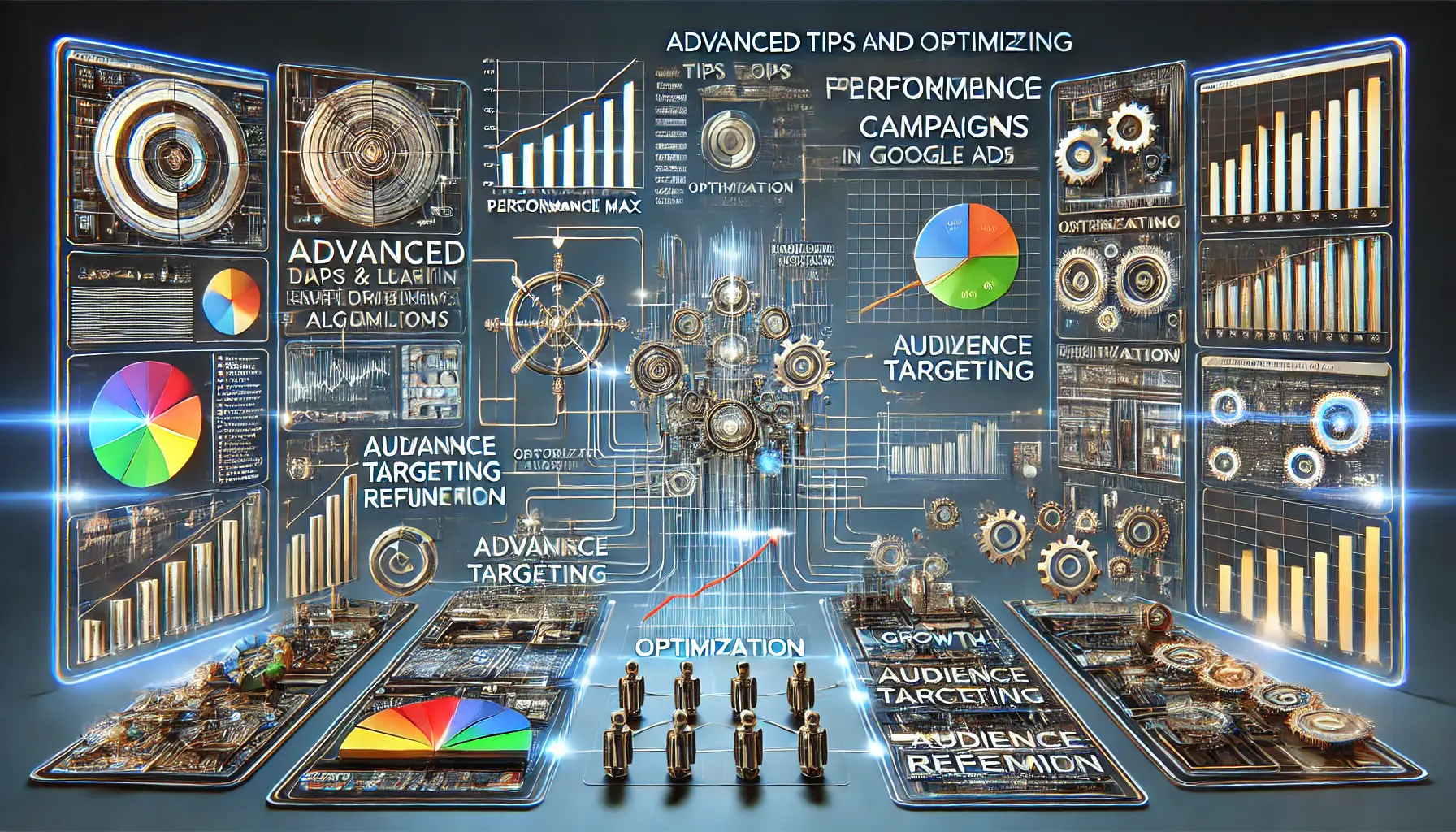
A visual representation of advanced tips and strategies for optimizing Performance Max campaigns, highlighting machine learning, data flows, and audience targeting refinement.
Advanced Tips and Strategies for Performance Max Campaigns
Once you have a concrete understanding of how Performance Max campaigns work and they are running smoothly, it’s time to explore advanced strategies to take your campaign’s performance to the next level.
These advanced techniques will help you push your campaigns further in terms of getting better ROI and ensuring that you fully leverage Google’s machine learning capabilities.
Below are some key strategies to get the most from your Performance Max campaigns.

A visual representation of leveraging machine learning and automation to optimize Performance Max campaigns, highlighting the use of AI and real-time data analysis.
Leveraging Machine Learning and Automation
One of the biggest advantages of Performance Max campaigns is leveraging the machine learning and automation that Google uses to optimize your ads across a wide variety of platforms.
Properly leveraging these tools can significantly enhance the effectiveness of your campaign.
Here’s how:
- Feed Google High-Quality Data: The more relevant data you provide through conversion tracking, audience signals, and creative assets, the better Google’s AI can optimize your campaign. Regularly update this data to maintain its freshness and relevance.
- Emphasize Consistent Conversion Tracking: Make sure your conversion tracking is set up correctly and aligns with your business goals. Without valid conversion data, Google’s machine learning will not be able to optimize effectively.
- Trust Google’s Automated Strategies: Performance Max heavily relies on Google’s automated strategies, such as Smart Bidding, to optimize your bids toward more conversions. Allow these tools time to learn and adjust before making manual changes.
- Use Seasonality Adjustments: If you anticipate seasonal fluctuations in user behavior, such as during a holiday season, make seasonality adjustments. This helps Google’s AI adapt to short-term changes within your business environment more quickly.
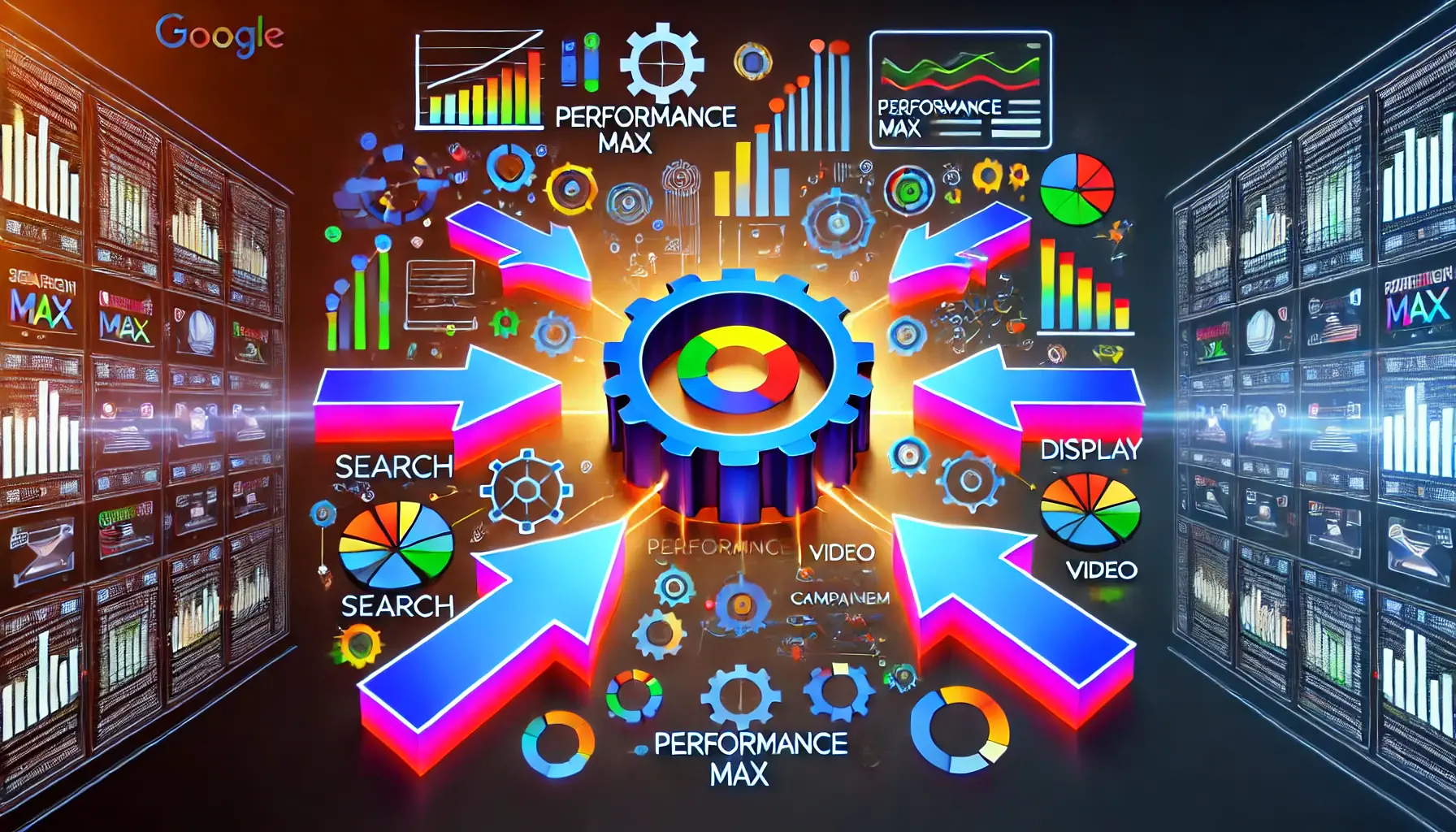
A visual representation of integrating Performance Max with other campaign types, highlighting the synergy between Search, Display, and Video campaigns.
Integrating Performance Max with Other Campaign Types
While Performance Max campaigns provide extensive reach and efficiency, they are even more effective when combined with other campaign types in Google Ads.
Here’s how to create synergy between Performance Max and your other campaigns:
- Combine with Search Campaigns: Run Performance Max alongside your existing Search campaigns to capture more intent-based traffic. Performance Max can help you reach users not covered by your Search ads, increasing overall coverage.
- Retarget Using Display Campaigns: Supplement your Performance Max campaign with Google Display Network (GDN) campaigns to retarget users who have already visited your website. This ensures you don’t miss potential conversions.
- Target Video Campaigns for Brand Awareness: Video ads, especially on YouTube, are highly effective for building brand awareness. Pairing these with Performance Max allows you to engage users who are familiar with your brand but haven’t yet converted.
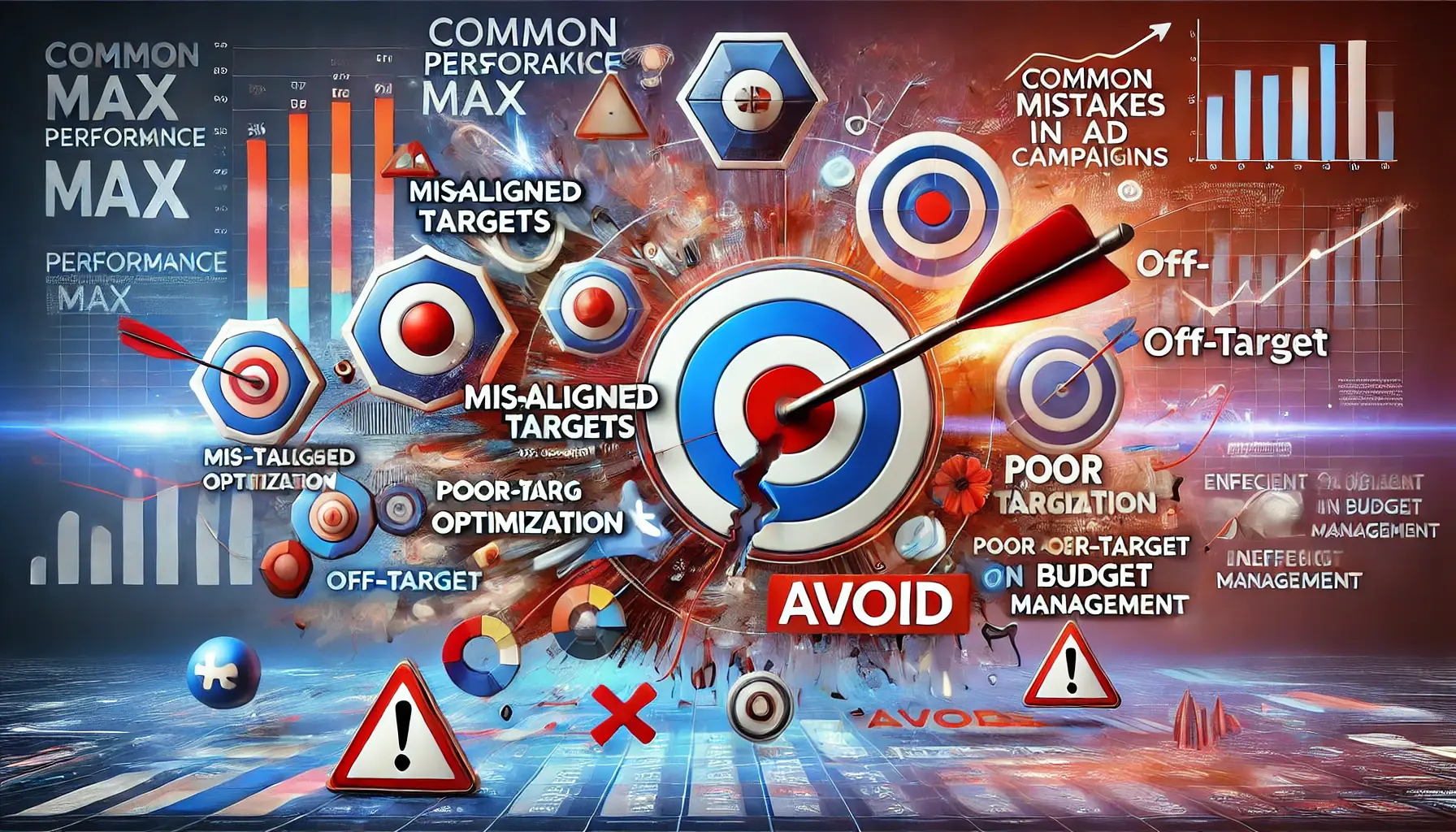
A visual representation of the common mistakes to avoid in Performance Max campaigns, symbolizing misaligned goals, poor optimization, and budget mismanagement.
Common Mistakes to Avoid in Performance Max Campaigns
Although Performance Max campaigns are powerful, there are common mistakes advertisers make that can hinder success.
Avoid the following pitfalls to ensure your campaigns are optimized:
- Not Providing Enough Creative Assets: Performance Max thrives on variety. Without a sufficient number of creatives (images, videos, headlines), Google won’t have enough material to optimize. Ensure you provide a wide array of assets for Google to find the best combinations.
- Ignoring Audience Signals: While Performance Max automates much of the targeting, audience signals help guide Google’s AI. Don’t neglect valuable audience data, such as custom audiences or first-party data, to help Google target the most relevant users.
- Setting Unrealistic Expectations: Machine learning takes time to optimize. Don’t expect immediate results. Give Google AI time to gather data and determine which strategies work best for your campaign before making drastic changes.
- Not Tracking the Right Conversions: Ensure the conversions you’re tracking align with your business goals. For example, if your goal is to increase sales, track purchase conversions rather than clicks or form submissions.
- Failing to Monitor Cross-Channel Performance: Since Performance Max runs across multiple Google platforms, it’s essential to monitor how each channel contributes to performance. Focusing only on one platform, like Search, could cause you to miss opportunities on YouTube or Display.
Avoiding these common mistakes and applying advanced optimization strategies will help you unlock the full potential of Performance Max campaigns, driving even better results for your advertising efforts.
Leveraging seasonality adjustments helps Google’s AI adapt to short-term changes in user behavior, maximizing campaign performance during key periods.
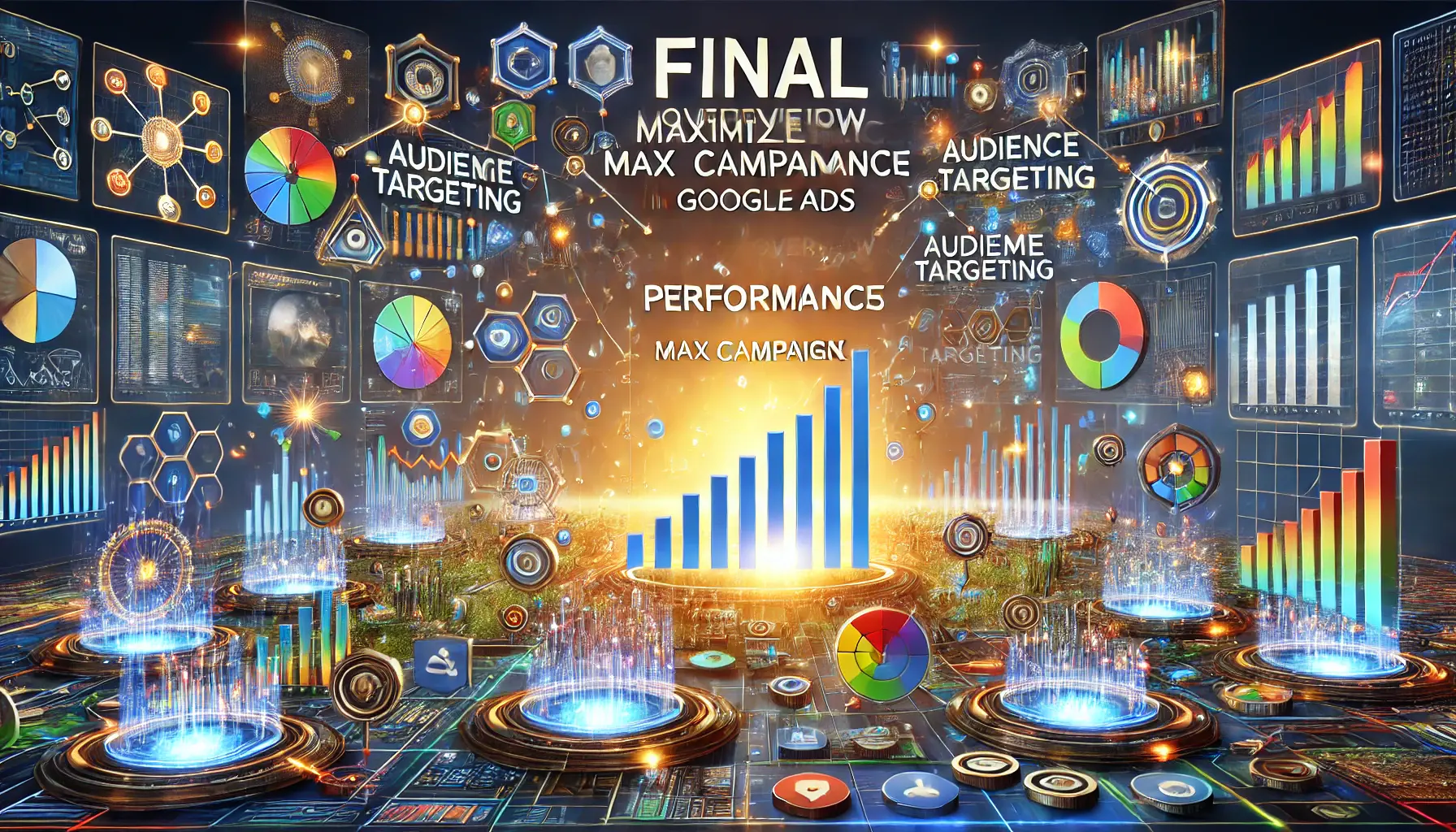
A visual representation of maximizing Performance Max campaigns, showing the integration of data analysis, machine learning, and growth strategies for campaign success.
Maximizing Performance Max Campaigns: Final Overview
Performance Max campaigns have a unique ability to help advertisers consolidate all of Google’s different campaign types into one singular, goal-based campaign.
This high-level campaign leverages Google’s machine learning and automation to drive better ad performance.
Like many other advertising tools, the full potential of Performance Max campaigns is realized when advertisers use it to its fullest and avoid common pitfalls.
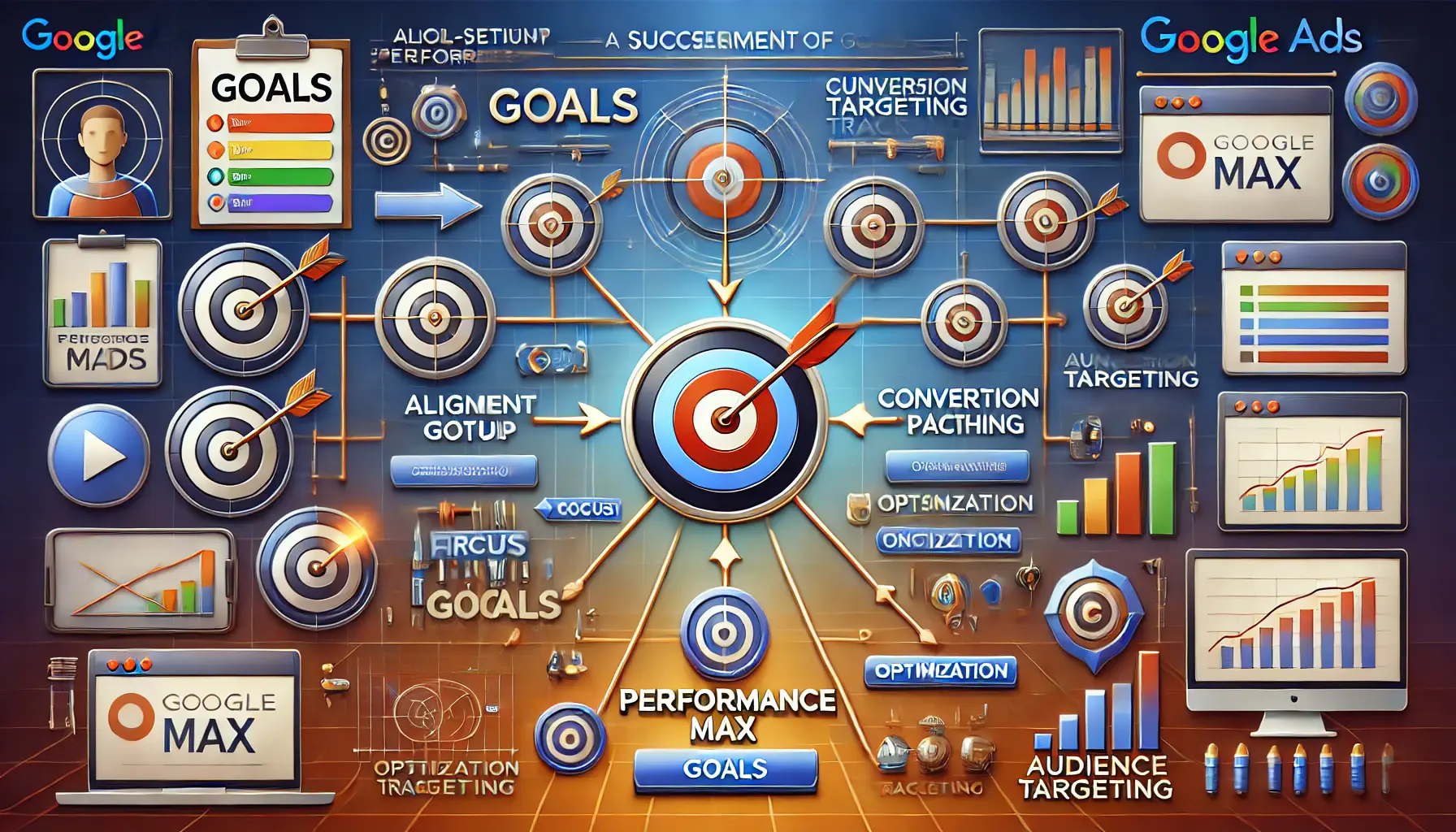
A visual representation of aligning and setting up goals for a successful Performance Max campaign, highlighting target setting, conversion paths, and performance tracking.
How to Align and Set Up Your Goals for a Successful Performance Max Campaign
The success of any Performance Max campaign starts with the setup.
Clearly defining your goals from the outset ensures your campaign aligns with your business objectives.
Whether you want to increase conversions, drive more traffic, or build brand awareness, setting the right goals is already the first step toward success.
Setting up accurate conversion tracking and audience signals gives Google’s machine learning the data it needs to optimize your ads.
Paying attention to these details early in the campaign setup can make all the difference as time goes on.
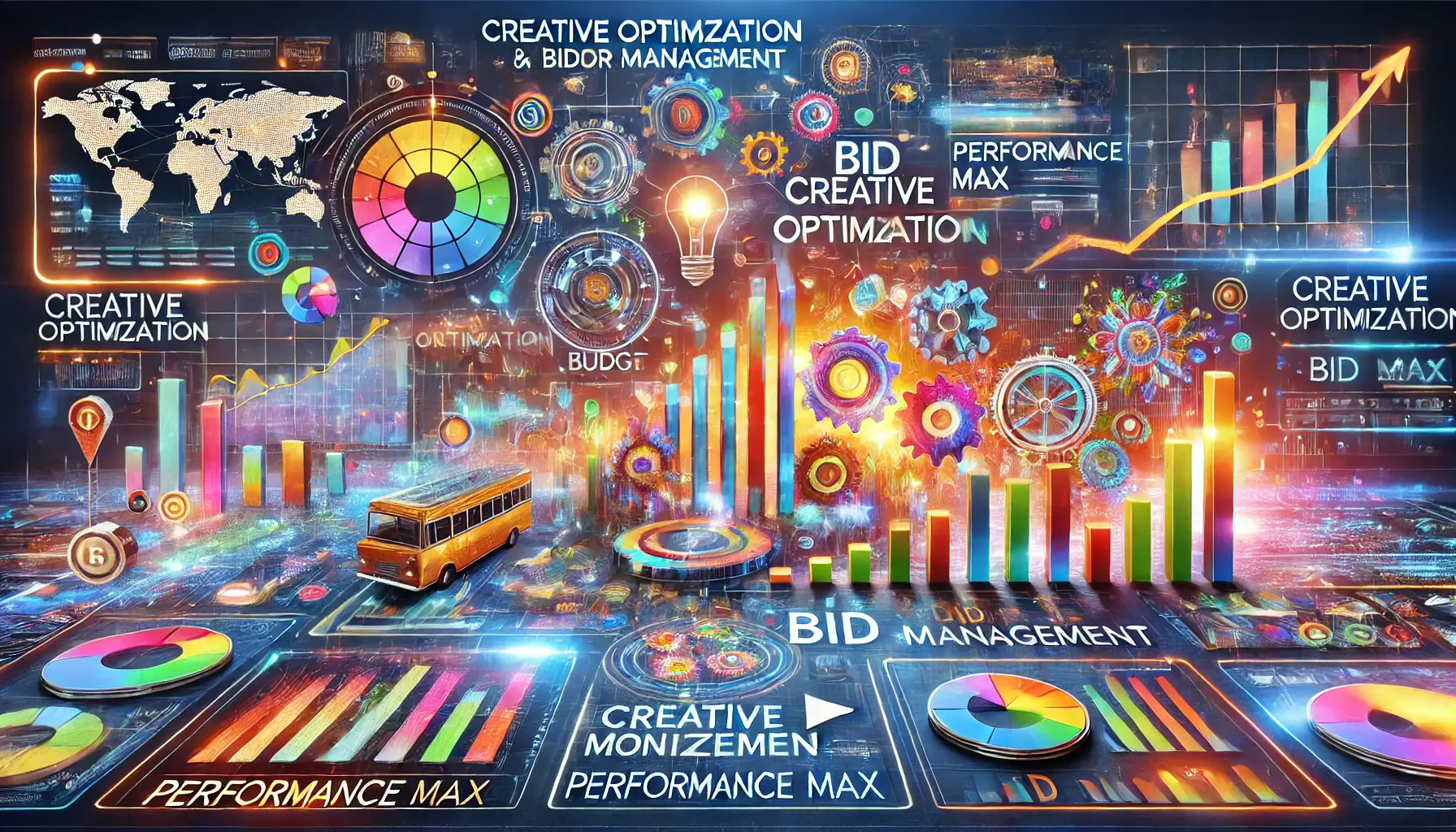
A visual representation of creative optimization and bid management, highlighting the adjustment of creative content and bids for optimal performance in digital campaigns.
Creative Optimization and Bid Management
At the heart of every ad campaign is creative content, and that’s no different for Performance Max campaigns.
By feeding high-quality visuals and videos with compelling copy into Google’s AI, you allow it to find the best-performing combinations that resonate with your audience.
Testing several variations and refreshing your creatives regularly helps avoid ad fatigue and keeps engagement high.
Equally important is managing your budget and bid strategy.
By using automated bidding strategies like Target CPA or Maximize Conversions, Google has the potential to optimize your campaign toward the most meaningful results.
Carefully monitor your budget to ensure it is being utilized effectively across different channels.
A visual representation of tracking, analyzing, and refining performance, highlighting real-time data analysis and optimization for improved digital campaign results.
Tracking, Analyzing, and Refining Performance
Once your campaign goes live, the key to continued success lies in regularly tracking and analyzing key performance metrics.
Monitoring conversions, CTR, CPA, ROAS, and other important metrics will help you understand how your Performance Max campaign is performing and where adjustments may be necessary.
Google Ads provides insights into cross-channel performance, asset optimization, and audience engagement, all of which should be revisited frequently to refine your approach.
Understanding what works allows you to make data-driven adjustments for continuous campaign improvement.

A visual representation of advanced strategies for better ROI, highlighting growth charts, performance analytics, and optimization techniques for improving campaign profitability.
Advanced Strategies for Better ROI
Advanced strategies for Performance Max campaigns include leveraging seasonality adjustments, integrating the campaign with other types such as Search, Display, and Video, and providing Google with high-quality first-party data.
Running Performance Max in tandem with other campaign types ensures that your reach and engagement are both broad and targeted.
By using advanced techniques and allowing time for Google’s machine learning to optimize, you can significantly improve the ROI of your Performance Max campaigns.

A visual representation of final thoughts in a campaign, highlighting the culmination of strategies, performance tracking, and optimization coming together for a successful outcome.
Final Thoughts
Performance Max campaigns offer a powerful opportunity for advertisers to maximize the performance of ads across Google’s platforms.
From setting clear goals and optimizing creative assets to managing budgets and analyzing performance metrics, Performance Max campaigns can deliver superior results.
By refining your approach and integrating advanced strategies, you can ensure long-term business growth and sustained success.
The full potential of Performance Max campaigns is realized when advertisers optimize creative content, set the right goals, and track key metrics consistently.

A visual representation of the ‘Frequently Asked Questions’ section, highlighting clarity and guidance on common queries related to Performance Max campaigns.
Your campaigns can be managed by an agency specialized in Google Ads, check out our service page.
Performance Max Campaigns: Frequently Asked Questions
Here are a set of commonly asked questions about Performance Max campaigns, providing quick insights into key aspects of how to use this campaign type effectively in Google Ads.
A Performance Max campaign is a goal-based ad format that uses Google’s machine learning capabilities to optimize ads across all Google platforms, including Search, Display, YouTube, and Gmail, using just one campaign.
While Smart campaigns focus primarily on automating ad placements in Search, Performance Max campaigns have a wider reach by running ads across all Google channels, utilizing more advanced machine learning for optimization.
Yes, every type of business can run Performance Max campaigns.
Whether you want to focus on conversions, traffic, or brand awareness, they are suitable for various goals and industries.
For Performance Max campaigns, high-quality visuals and captivating videos are crucial.
Providing a wide range of creative assets allows Google’s machine learning to optimize for the best-performing combinations.
It typically takes around two to four weeks for Google’s machine learning to gather enough data to optimize your Performance Max campaigns.
Allow the system time to adjust and learn.
Yes, Performance Max campaigns can be run alongside Search, Display, and Video campaigns to help increase overall reach and better target different stages of the customer journey.
Important metrics to track in Performance Max campaigns include conversions, click-through rate (CTR), cost per conversion (CPA), return on ad spend (ROAS), and overall impressions to gauge campaign performance.
Automated bidding strategies like Target CPA and Maximize Conversions work well in most Performance Max campaigns.
These strategies enable Google’s machine learning to optimize bids for better results.
Yes, you can use first-party data, such as customer lists and website visitors, as audience signals in Performance Max campaigns to enhance targeting and improve performance.












